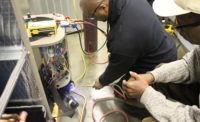The renewable energy sector of the HVAC marketplace continues to make strides in acceptance and understanding from consumers, and the proof is in the numbers.
Per WaterFurnace Intl. Inc., more than 1 million geothermal (or ground-source) heat pumps are used in U.S. residential, commercial, and government buildings. And, that number is growing as U.S. homeowners install approximately 50,000 more geothermal heat pumps annually. Similarly, both wind and solar installations have risen steadily over the last decade, with solar accounting for 32 percent of the nation’s new generating capacity in 2014, besting the efforts of both wind energy and coal for the second consecutive year, per Scientific American.
LEARNING ON THE FLY
As renewable energy systems continue to become more desirable, the need for qualified installers continues to grow. According to the U.S. Bureau of Labor Statistics (BLS), the median pay for solar photovoltaic (PV) installers is $37,900 per year or $18.22 per hour. The sector is expected to grow at a 24 percent clip between now and 2022, employing 6,000 individuals, which, based on BLS statistics, is much faster than the average growth for all occupations.
The potential extension (or dismissal) of current federal renewable tax credits at the end of 2016 (see Page 10 for more details) and the improved efficiency of solar panels could also impact the demand for PV installers nationwide.
Those who already have the requisite training clearly have the upper hand as the market continues to emerge and take shape, as both manufacturers and contractors are adapting the technology.
“We have an on-the-job training certification step our dealers are trying to use,” said Derek Phillips, electrical engineer, Lennox Intl. Inc. “We want to keep solar installs as similar to HVAC installs as possible because that makes it better for the technicians. So, for us, the electrical equipment is similar, and the biggest learning curve actually comes from the roof work itself.”
Lennox’s SunSource Home Energy System, which was introduced to the marketplace in 2010, generates solar energy for initial use in a heat pump or air conditioner. When the heating or cooling system is not in use, the solar energy can be used to operate other appliances and electronics. Excess energy can then be sent back to the utility company.
“One of our solar program’s biggest goals has been and continues to be helping empower HVAC dealers,” said Phillips. “It’s a great pairing for dealers to adapt solar as part of their programs because it has many benefits. In the traditional offseason, it’s great for dealers to offer solar installations and to show customers.”
GAINING THE NECESSARY TRAINING
While an on-the-job training program, like the one offered at Lennox, can be a great asset, technicians may also consider attending an energy conservation or renewable energy program at a local technical college.
Drake State Technical College in Huntsville, Alabama, features an 800-square-foot renewable energy laboratory to teach students solar thermal, solar photovoltaic, and geothermal installations.
“We’ve had area contractors come to us and insist they need graduates with renewable energy training,” said John Reutter, president, Drake State, per AL.com. “We’re seeing more future jobs that require energy training.”
At Northwestern Michigan College (NMC) in Traverse City, Michigan, an associate of applied science degree is offered in renewable energy technology. The NMC coursework takes place within a mobile solar lab, a geothermal heat pump lab, a solar thermal system, and an 8-kW grid-interconnected solar array.
Outside of traditional courses, such as those offered at Drake State and NMC, an abundance of HVAC training is occurring online, courtesy of organizations like Solar Energy Intl.
In other words, if a technician or HVAC student has the desire to become educated and trained in renewables, the opportunities are readily available across the country.
“There is a big portion of renewables training that we need to teach our technicians,” said Vaughan Woodruff, owner, Insource Renewables, Pittsfield, Maine. “Half of them come in with very little to no experience with solar technology. Our business is fairly small, but we’re about the average size for the solar industry. What we tend to do is build our staff around the people who make it up. We conduct internal training if a technician fits in with what we’re about. We have five folks with some sort of educational background in solar, and other folks we train firsthand.”
Josh Teekell, CEO and cofounder, Mistbox, also mentioned it’s important consumers and technicians realize all that solar entails before getting involved.
“With regard to HVAC, when people think of solar, they only think of the solar panels on their houses or maybe a light along their walkway,” said Teekell. “Applications for more solar consumer products have come a long way in a short amount of time, and consumption is much better and has a higher potential to power Internet of Things (IoT) products. In general, consumers and contractors need to become more aware. In some ways, this is an uphill battle, because people don’t fully understand the technology yet.”
While many may not have a firm grasp on the technology just yet, the growth of renewables is undeniable, and it will be interesting to see if the projections given out by the BLS prove true in the coming years.
Publication date: 8/31/2015
Want more HVAC industry news and information? Join The NEWS on Facebook, Twitter, and LinkedIn today!







Report Abusive Comment